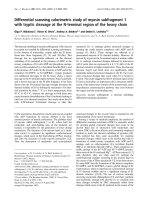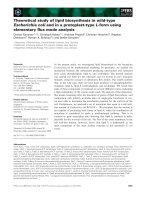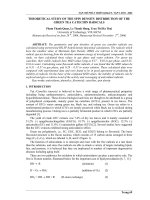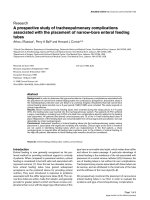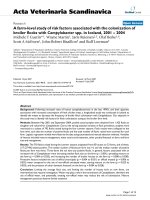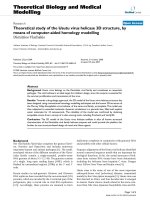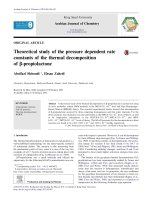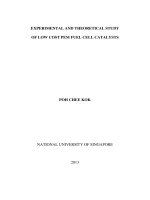Theoretical study of the efficiency of liquid chromatography columns with particle size gradient
Bạn đang xem bản rút gọn của tài liệu. Xem và tải ngay bản đầy đủ của tài liệu tại đây (634.31 KB, 8 trang )
Journal of Chromatography A 1651 (2021) 462331
Contents lists available at ScienceDirect
Journal of Chromatography A
journal homepage: www.elsevier.com/locate/chroma
Theoretical study of the efficiency of liquid chromatography columns
with particle size gradient
Szabolcs Horváth a, Fabrice Gritti b, Krisztián Horváth a,∗
a
b
Research Group of Analytical Chemistry, University of Pannonia, Egyetem utca 10, Veszprém H-8200, Hungary
Waters Corporation, 34 Maple Street, Milford, MA 01757, United States
a r t i c l e
i n f o
Article history:
Received 24 July 2020
Revised 4 June 2021
Accepted 6 June 2021
Available online 9 June 2021
Keywords:
Particle size gradient
Physical bandwidth
Efficiency
Isocratic
Gradient elution modes
Stationary phase design
a b s t r a c t
Modern analytical applications of liquid chromatography require more and more efficient columns. In this
work, the possibility of utilizing particle size gradient in the chromatographic column was studied by a
theoretical approach. In the course of our work three different scenarios of particle size gradients were
considered with different shapes (linear, convex and concave). The evolution of bandwidth inside the column was plotted for each scenario. As a reference point, the bandwidth of the uniform column was used,
which had the same pressure drop as the non-uniform column. According to our calculations, in isocratic
elution mode, the non-uniform column does not offer any advantage compared to the uniform column,
regardless the type of the particle size gradient. In gradient elution mode, however, extra band compression occurs was found. For negative particle size gradients, the final physical bandwidth was found to be
approximately 1–4 % smaller than for uniform columns. This slight gain in efficiency in terms of bandwidth compression can be expanded to 5–8 % by the optimization of the limiting particle sizes. These
optimized results are obtained when the final particle size is approximately 40% of the initial particle
diameter.
© 2021 The Authors. Published by Elsevier B.V.
This is an open access article under the CC BY license ( />
1. Introduction
For complex samples, single column liquid chromatography often does not provide separations with adequate resolution and
analysis time [1]. There are several approaches that combine stationary phases to improve chromatographic performance. The use
of parallel columns is the simplest approach: the analysis is performed in two runs. The second run has the aim to resolve the
overlapped compounds in the first run. A rather sophisticated software is often required to find true complementary situations that
give adequate resolution of all analytes [2,3].
Stationary phases of mixed-mode columns exhibiting intermediate selectivity can be prepared by combining different separation
mechanisms, such as reversed phase or size exclusion, and cation
or anion exchange. Mixed-mode columns manifest the properties
of each constituent stationary phase. By changing their ratio, the
selectivity can be adjusted [4–6]. However, mixed-mode column
approach might have some difficulties. First, dedicated columns
are needed. Second, the interaction of different types of stationary
phases with each other can give rise to complex non-linear retention behaviours [7].
∗
Corresponding author.
Tandem columns in a multi-dimensional configuration can be
an alternative to mixed-mode columns. In this approach, the elution of the sample goes through two or more tandem (i.e., subsequent) columns, each one packed with a specific stationary phase.
The separation in the second dimension can involve all the fractions collected in the first dimension (comprehensive approach)
[8–10], or only selected fractions (heart-cutting approaches) [11–
14]. Along with the advantage of combined utilization of different
retention mechanisms, two-dimensional LC offers the opportunity
to manipulate independently the experimental conditions (eluent
composition, gradient program, flow rate, and temperature), for
each particular column. Main disadvantages are the considerable
sample dilution that may occur and the longer analysis times. In
addition, optimization in two-dimensional LC is not straightforward due to a large number of interdependent factors[1].
A technically more simple design is the tandem columns in a
serial configuration. The idea is to connecting directly two or more
columns in series and flowing the same mobile phase (or gradient)
through all columns. With a given serially coupled column combination, a quasi-new column is obtained, which in some instances
have much better performance, than the individual columns [3].
The idea of coupling the columns already arose at the dawn
of the history of chromatography when analyzing complex sam-
/>0021-9673/© 2021 The Authors. Published by Elsevier B.V. This is an open access article under the CC BY license ( />
S. Horváth, F. Gritti and K. Horváth
Journal of Chromatography A 1651 (2021) 462331
of bands of compounds inside the column, σz2 , can also be determined by solving the following ordinary differential equation [33]:
ples [15–18]. In the case of column coupling, on the one hand,
the kinetic performance can be increased by increasing the column length, and on the other hand, the selectivity can be adjusted
by combining the stationary phases with different chemistry [19].
Some reports [18,20] also highlighted the increased number of
drugs that could be monitored using coupled columns. Besides the
development of analytical procedures, an attempt was made to use
serially coupled columns in preparative chromatography for separating multi-component mixtures [21]. The authors reported an
enhanced production by coupling two columns in series. It should
be finally commented that the analysis of samples containing mixtures of chiral and achiral compounds, by coupling chiral and achiral stationary phases, is another active field [22–26].
The foundations of the kinetic theory of separation in an arbitrary linear medium (time-varying and / or non-uniform) were
explained in details by Giddings [27,28] and Blumberg [29,30]. In
these studies, a detailed model for calculating the theoretical plate
height in non-uniform medium is provided. These theories also extend to the case of coupled columns and gas chromatography, taking into account the gas compression effects as well.
Fekete et al. [19] developed a theory for both isocratic and gradient modes, to predict the peak widths for coupled column systems. They concluded that in isocratic mode, the plate numbers
are not additive when the columns possess different plate count,
and kinetic performance has a limiting value which depends on
the efficiency and length of the individual columns. In gradient
elution mode, the column order is no longer indifferent. The observed apparent efficiency significantly depends on the column order. In combinations, when the latter column has higher efficiency,
a decrease in the peak width is predicted. Therefore, the columns
should be placed in order of increasing efficiency.
As previously seen, decreasing particle size along columns (in a
coupled system) can result in extra peak sharpening effect in addition to the common gradient band compression [19,31]. In a recent
work, Codesido et al. [32] studied the potential of columns packed
with particles of decreasing size (particle size gradient). They reported that in isocratic elution mode, varying particle size does not
present any advantage. However, in gradient elution mode, with
steep mobile phase gradient, the potential benefit of a particle size
gradient might become important. In the best scenario, about 15–
20% increase in efficiency can be expected at a given retention time
when utilizing a particle size gradient, compared to constant particle size.
The purpose of this work is to study the evolution of the bandwidth in non-uniform columns by a theoretical approach considering different scenarios for particle size gradients.
dσz2
kz + 1
kz
= Hz
dz
2
(2)
where Hz and kz are the local height equivalent to a theoretical
plate, HETP, and the local retention factor. Hz can be calculated by
the Knox equation in the knowledge of the local particle size:
Hz = A νz1/3 +
B
νz
+ C νz d p ( z )
(3)
where νz is the reduced linear mobile phase velocity:
νz =
u0 d p ( z )
Dm
(4)
and Dm is the diffusion coefficient of the solute molecules. Note,
that by using this approach, the same u0 might be optimal for a
given particle diameter and not optimal for any other particle sizes.
The physical bandwidth, 4σz , is the spatial width of a concentration profile of a solute inside the chromatographic column.
In reversed phase gradient elutions, the local retention factor of
the compound is determined as
kz =
kϕ0
(5)
ϕ /tG (z/u0 )
1 + kϕ0 S
where kϕ0 is the retention factor of solute at the beginning of analysis (ϕ = ϕ0 ):
kϕ0 = k0 exp(−S ϕ )
(6)
ϕ is the volume fraction of the stronger eluent modifier, S is a
practical measure of the retention sensitivity of a compound toward the change of eluent composition (-S is the slope of ln k[ϕ ]
vs. ϕ plot), ϕ is the change of stronger eluent component in tG
gradient time and k0 is the retention factor of the compounds for
ϕ = 0.
2.2. Equivalent particle diameter
Pressure drop of a column in which particle diameter varies axially can be calculated by Darcy’s law:
dP
φ u0 η
=− 2
dz
d p (z )
(7)
where z is the spatial variable, d p (z ) the particle diameter that is a
function of z, η the dynamic viscosity of the eluent, and φ the column resistance factor which is in the range of 50 0–10 0 0 (10 0 0 is
assumed in this work). By neglecting the effect of viscous heating
on u0 and η, Eq. (7) can be solved as
2. Theory
L
P = φ u0 η
2.1. Efficiencies of non-uniform columns
1
dz
d2p (z )
0
(8)
where L is the column length. If the particle diameter is constant
throughout the column, Eq. (8) simplifies into Kozeny-Carman
equation, that is a well known relation used in fluid dynamics to
calculate the pressure drop of a fluid flowing through a packed bed
of solids, and is only valid for laminar flow [34,35].
Equivalent particle diameter, d p,e , can be defined as the diameter of particles packed in a non-gradient, uniform column which
generates the same pressure, P , as a column with particle-size
gradient.
For a chromatographic column with a gradient in particle size,
the differential mass balance equation of equilibrium dispersive
model can be written as:
u0 ∂ c
∂c
1 ∂
∂c
=−
+
D
∂t
1+k∂z
1+k∂z
∂z
kz +1 2
kz
(1)
where t is the time variable, c is the concentration of the compound in the mobile phase and D is the longitudinal dispersion
coefficient. Since the particle diameter changes throughout the column axis, value of D depends on the spatial variable, z.
The efficiency of the chromatographic column with a gradient
in particle size can be determined by calculating the retention time
and peak variance from the solution of Eq. (1).
Assuming that zones of analytes are so narrow that particle
sizes can be considered nearly constant within the zone, variances
d p,e =
1
L
L
0
1
d2p
(z )
− 12
dz
=
φ u0 η L
P
(9)
The column packed with the equivalent particle diameter acts
as a reference, whose efficiency can be compared to the different
particle-size-gradient columns.
2
S. Horváth, F. Gritti and K. Horváth
Journal of Chromatography A 1651 (2021) 462331
Table 1
The values of the numerical parameters necessary for the numerical
calculations.
Parameter
Value
column length (L)
parameters of the Knox equation (A, B, C)
molecular diffusion coefficient (Dm )
column resistance factor (φ )
linear mobile phase velocity (u0 )
eluent viscosity (η )
initial molar fraction of the stronger eluent (ϕ0 )
change of the eluent composition ( ϕ )
retention factor for ϕ = 0 (k0 )
retention sensitivity (S)
gradient time (tG )
0.05 m
1, 1.5, 0.05
10−9 m2 /s
1000
0.0111 m/s
10−3 Pas
0.05
0.7
104
30
600 s
(b) negative gradient
⎡
d p (z ) = d p,0 + d p,L ⎣1 −
( Lz )
i
d p,0
d p,L
⎤
⎦
(15)
where i is a positive integer (i = 1 or 5 in this work).
where d p,0 and d p,L are particle size diameters at the beginning
and end of the column, respectively.
The shape of the different particle size gradients are illustrated
in Fig. 1 in case of positive gradients.
4. Results and discussions
4.1. Determination of equivalent particle diameters
3. Methods
In order to be able to compare the columns with different particle size gradients with uniform columns in respect of efficiency,
the column pressure was used as a reference point. Pressure drops
of the non-uniform columns were calculated by substituting the
different d p (z ) scenarios (Eqs. (10)–(15)) into Eq. (7). With the
knowledge of the pressure drops of the non-uniform columns, the
equivalent particle diameter can be determined by inserting the
calculated P values to Eq. (9) for each scenario. When d p,e is determined for a given particle size gradient scenario, a theoretical
reference column will be obtained, so it can be decided whether
the non-uniform column has better or worse separation power
compared to this reference column.
In Fig. 2, the pressure profile of the non-uniform and reference
columns are plotted for the linear and convex particle size gradients. It is apparent that the pressure drop curve of the positive
gradient is a concave function, while the negative gradient has a
convex pressure profile. It is also apparent that these two curves
are point symmetric and the center of the symmetry is the middle of the column. Obviously, the pressure change is more significant in the region of the column where small particles are located.
That is, in the case of a negative particle size gradient, the pressure changes more strongly at the end of the column, while in the
case of a positive particle size gradient, the pressure changes more
strongly at the column head. The calculated P and d p,e values are
summarized in Table 2. Note, that the equivalent particle diameters are presented in the Table in two decimal precision. Obviously,
it is not possible to prepare particles with that precision. However, this precision was necessary due to the sensitivity of pressure
drop toward the particle size variations. The data prensented in
Table 2 shows that convex scenarios produce larger pressure drops
than linear and concave particle size gradients. Note that the particle diameters varied between 2.0 and 10.0 μm in each case.
3.1. Parameters of calculations
The numerical calculations were carried out with a software
written in house in Python programming language (v. 3.6, Anaconda Python Distribution), using the NumPy and SciPy packages.
The values of the numerical parameters necessary for the numerical calculations, such as the column and the molecular parameters
are listed in Table 1. Note that the retention sensitivity parameter,
S, has a quite high value. That large value was deliberately chosen in order to represent large polymers and proteins. Since S has
an impact on the overall evolution of bandwidth, solute size might
have a minor impact on the efficiency of columns possessing particle size gradients.
3.2. Particle size gradients
In the course of our work, three scenarios with different stationary phase particle size gradients were studied. For each scenario both the positive and negative gradients were examined, and
the calculated efficiencies (physical bandwidth at the end of the
column) of these non-uniform columns were compared to the efficiency of the uniform column (the column with the same pressure
drop as the non-uniform column, packed with the particles of the
equivalent diameter). These three scenarios were the following:
1. Linear gradient
(a) positive gradient
d p (z ) =
d p,L − d p,0
z + d p,0
L
(10)
(b) negative gradient
d p (z ) =
d p,0 − d p,L
z + d p,L
L
(11)
4.2. Isocratic elution mode
2. Convex gradient
(a) positive gradient
d p (z ) = d p,0
Based on the determination of equivalent particle diameters, efficiencies of non-uniform (particle-size-gradient) columns can be
compared with reference uniform columns for both isocratic and
gradient elution modes. If the physical bandwidth at the end of the
( )
z
L
d p,L
d p,0
i
(12)
(b) negative gradient
Table 2
Pressure drop and equivalent particle diameter
values for the five scenarios.
( L−zL )
i
d p (z ) = d p,L
d p,0
d p,L
3. Concave gradient
(a) positive gradient
(13)
Scenario
⎡
d p (z ) = d p,L + d p,0 ⎣1 −
( L−zL )
i
d p,L
d p,0
Linear
Convex
Convex quinteda
Concave
Concave quinted
⎤
⎦
(14)
a
3
P (bar)
277.5
413.8
1005.5
192.0
88.6
d p,e (μm)
4.47
3.66
2.35
5.38
7.91
quinted means: “to the fifth power”
S. Horváth, F. Gritti and K. Horváth
Journal of Chromatography A 1651 (2021) 462331
Fig. 1. Variation of the particle diameter along the column length in case of positive gradients.
a
b
C
Fig. 2. Pressure drop curves of the non-uniform columns for positive (blue) and negative (orange) particle size gradients plotted together with the pressure drops of the
reference columns (green) for (a) linear, (b) convex, and (c) convex-quinted particle distribution scenarios. (For interpretation of the references to color in this figure legend,
the reader is referred to the web version of this article.)
non-uniform column is smaller compared to the bandwidth at the
end of the reference column, then it offers better separation power.
For the calculations of physical bandwidths, Eq. (2) was used. Since
in isocratic elution mode the retention factor, k, does not change
with the spatial variable, z, Eq. (2) can be simplified as:
dσz2
= Hz
dz
columns and of the uniform columns are concave functions. The
bandwidth curves of the positive gradient columns have inflection
points. This is most significant in case of convex quinted scenario.
In case of positive particle size gradient, the widths of chromatographic bands are always bigger all along its migration through the
columns compared to the uniform column. In case of negative particle size gradient, however, the bandwidth is smaller in the beginning compared to the reference column, since the initial particle
sizes are smaller than that of the uniform column. As the particle sizes increase, the bandwidths increase rapidly. Finally, at the
end of the column, the bandwidths are the same for positive and
negative particle size gradients as well. Accordingly, in case of iso-
(16)
In Fig. 3, the evolution of the width of bands of compounds inside the column (4σz ) can be seen for non-uniform columns and
the corresponding reference columns in case of isocratic elution
mode. The bandwidth curves of the negative particle-size-gradient
4
S. Horváth, F. Gritti and K. Horváth
Journal of Chromatography A 1651 (2021) 462331
a
b
C
Fig. 3. Variation of the physical bandwidth inside the column for the non-uniform columns with positive (blue) and negative (orange) particle size gradients plotted together
with the bandwidth curve of the reference column (green) in case of (a) linear, (b) convex and (c) convex-quinted particle size gradient scenarios. (For interpretation of the
references to color in this figure legend, the reader is referred to the web version of this article.)
Table 3
Bandwidth values (mm) at the end of the column for the five scenarios in isocratic
elution mode.
Scenario
Linear
Convex
Convex quinted
Concave
Concave quinted
Table 4
Bandwidth values (mm) at the end of the column for the five scenarios in gradient
elution mode.
Physical bandwidth (mm)
Scenario
positive gradient
negative gradient
uniform column
3.50
3.12
2.78
3.86
4.56
3.50
3.12
2.78
3.86
4.56
2.84
2.52
1.98
3.19
2.50
Linear
Convex
Convex quinted
Concave
Concave quinted
cratic elution mode, non-uniform columns are identical regarding
their efficiencies. The direction of the particle size gradient does
not affect the overall separation power.
The calculated physical bandwidth values are summarized in
Table 3 for each scenarios. The main conclusion of Fig. 3 and
Table 3 is that uniform columns always provide higher efficiencies
than non-uniform columns in case of isocratic elution mode. The
same conclusion was drawn by studying serially coupled columns
under isocratic conditions [31].
Physical bandwidth (mm)
positive gradient
negative gradient
uniform column
2.49
2.28
1.66
2.67
2.91
1.70
1.47
1.15
1.94
2.55
1.72
1.53
1.20
1.93
2.50
column. In case of the convex quinted scenario, the bandwidths
are constant in 80% of the column. As a result of the band compression, in case of negative particle size gradients, the final physical bandwidths may be smaller than for uniform columns. When
the particle size gradient was linear, the advantage of non-uniform
column was ∼ 1%. For convex and convex quinted scenarios the
bandwidths was ∼ 4% thinner than in case of uniform column.
Accordingly, the steepness of the decrease of the particle diameter towards the end of the column is a decisive factor regarding the evolution of the physical bandwidth. The concave gradient did not offer better separation power compared to the uniform
column.
Amongst the non-uniform columns Scenario 2 with negative
particle size gradient offered the highest efficiency but it also had
the highest pressure drop (smallest d p,e ).
The calculated physical bandwidth values are summarized in
Table 4. Note that, since the gain of efficiency is characterized by
the physical widths of solute bands at the end of the column, this
gain in efficiency can be converted to resolution or peak capacity
improvement directly.
4.3. Gradient elution mode
The same plots were generated for gradient elution mode as in
the previous section, only this time Eq. (2) was used in its full
form – since in this case, k, changes with, z, – to determine the
shape of the bandwidth functions. The plots presented in Fig. 4
are very similar to the isocratic ones (Fig. 3), but there are some
important differences to note. First, that columns with positive and
negative particle size gradients cannot be considered identical regarding their efficiencies. Negative particle size gradients offer significantly better separation power than columns with positive particle size gradients. In the latter case, none of the scenarios offered better efficiencies compared to the uniform column. In case
of negative particle size gradient, however, band compression can
be observed. For the linear and convex scenarios, even the narrowing of bandwidths can be observed in the last section of the
4.4. Optimization of limiting particle sizes
The important conclusion of the previous section, that by delicately choosing the shape and type of particle size gradient, application of non-uniform columns with negative particle size gra5
S. Horváth, F. Gritti and K. Horváth
Journal of Chromatography A 1651 (2021) 462331
a
b
C
Fig. 4. Variation of the physical bandwidth along the column for the non-uniform columns with positive (blue) and negative (orange) particle size gradients plotted together with the bandwidth curves of the reference, uniform columns (green) in case of (a) linear, (b) convex and (c) convex-quinted particle size gradient scenarios. (For
interpretation of the references to color in this figure legend, the reader is referred to the web version of this article.)
a
b
c
Fig. 5. Ratios of the uniform and non-uniform column bandwidths as a function of particle diameter at the end of the column in case of (a) linear, (b) convex and (c)
concave particle size gradient scenarios.
dients can be a potential minor improvement to achieve more efficient separations. The column efficiency can be further optimized
by the variation of limiting particle sizes (d p,0 , d p,L ). In Fig. 5,
the physical bandwidths of sample compounds at the end of nonuniform columns relative to the uniform case as a function of the
final particle diameter, d p,L , can be seen at three different initial
particle sizes (d p,0 = 5, 10, 20 μm). When the ratio is below one,
the non-uniform column has better efficiency than the uniform
one. Fig. 5 shows clearly that the minimal (final) particle diame-
ter has a significant effect on the overall separation efficiency. The
optimum of the curves is reached when the final particle size is
approximately 40% of the initial particle diameter. In case of linear and convex scenarios (Fig. 5a and b) the efficiency gain is close
to 6–8% in terms of band width reduction. Note, that even in case
of the concave scenario (Fig. 5c), the column efficiency can be improved by 5% in spite of the suggestions of the results of previous
sections. Fig. 5 emphasizes the importance of in-silico optimization
of novel stationary phase structures.
6
S. Horváth, F. Gritti and K. Horváth
Journal of Chromatography A 1651 (2021) 462331
5. Conclusions
[6] R. Nogueira, M. Lämmerhofer, W. Lindner, Alternative high-performance liquid chromatographic peptide separation and purification concept using a new
mixed-mode reversed-phase/weak anion-exchange type stationary phase, J.
Chromatogr. A 1089 (2005) 158–169.
[7] E.Y. Ordoñez, J.B. Quintana, R. Rodil, R. Cela, Computer assisted optimization
of liquid chromatographic separations of small molecules using mixed-mode
stationary phases, J. Chromatogr. A 1238 (2012) 91–104.
[8] S.P. Dixon, I.D. Pitfield, D. Perrett, Comprehensive multi-dimensional liquid
chromatographic separation in biomedical and pharmaceutical analysis: a review, Biomed. Chromatogr. 20 (2006) 508–529.
[9] P. Jandera, Comprehensive two-dimensional liquid chromatography – practical
impacts of theoretical considerations. a review, Cent. Eur. J. Chem. 10 (2012)
844–875.
ˇ
[10] P. Jandera, T. Hájek, M. Stanková,
Comprehensive two-dimensional liquid chromatography – practical impacts of theoretical considerations. A review, Anal.
Bioanal. Chem. 407 (2015) 139–151.
[11] J. Ma, X. Hou, B. Zhang, Y. Wang, L. He, The analysis of carbohydrates in
milk powder by a new “heart-cutting” two-dimensional liquid chromatography method, J. Pharm. Biomed. Anal. 91 (2014) 24–31.
[12] R.A. Shalliker, Two-dimensional HPLC analysis of oligostyrenes: comprehensive
and online heart-cutting techniques, J. Sep. Sc. 32 (2009) 2903–2911.
[13] C.S. Milroy, G.R. Dennis, R.A. Shalliker, Targeted isolations from complex samples using two-dimensional HPLC. Part 1: analytical scale analysis, J. Liq. Chromatogr. Rel. Technol. 35 (2012) 1481–1496.
[14] C.S. Milroy, G.R. Dennis, R.A. Shalliker, Targeted isolations from complex samples using two-dimensional HPLC. Part 2: a semi-continuous heart cutting, J.
Liq. Chromatogr. Rel. Technol. 35 (2012) 1921–1932.
[15] J.L. Glajch, J.C. Gluckman, J.G. Charikofsky, J.M. Minor, J.J. Kirkland, Simultaneous selectivity optimization of mobile and stationary phases in reversed-phased liquid chromatography for isocratic separations of phenylthiohydantoin amino acid derivatives, J. Chromatogr. A 318 (1985) 23–39.
[16] P.H. Lukulay, V.L. McGuffin, Solvent modulation in liquid chromatography: extension to serially coupled columns, J. Chromatogr. A 691 (1995) 171–185.
[17] F. Garay, Application of a flow-tunable, serially coupled gas chromatographic capillary column system for the analysis of complex mixtures, Chromatographia 51 (20 0 0) 108–120.
[18] K. Chen, F. Lynen, M. De Beer, L. Hitzel, P. Ferguson, M. Hanna-Brown, P. Sandra, Selectivity optimization in green chromatography by gradient stationary phase optimized selectivity liquid chromatography, J. Chromatogr. A 1217
(2010) 7222–7230.
[19] S. Fekete, S. Codesido, S. Rudaz, D. Guillarme, K. Horváth, Apparent efficiency
of serially coupled columns in isocratic and gradient elution modes, J. Chromatogr. A 1571 (2018) 121–123.
[20] E. Deconinck, A. Kamugisha, P. van Campenhout, P. Courselle, J.O. De Beer, Development of a stationary phase optimised selectivity liquid chromatography
based screening method for adulterations of food supplements for the treatment of pain, Talanta 138 (2015) 240–246.
[21] B. Sreedhar, A. Seidel-Morgenstern, Preparative separation of multi-component mixtures using stationary phase gradients, J. Chromatogr. A 1215 (2008)
133–144.
[22] Y.Q. Chu, I.W. Wainer, Determination of the enantiomers of verapamil and
norverapamil in serum using coupled achiral-chiral high-performance liquid,
J. Chromatogr. B 497 (1989) 191–200.
[23] D.V. Johnson, I.W. Wainer, Enantioselective separation of cyclic chiral ketones
and their corresponding diastereomeric alcohols by HPLC on chiral and chiral/chiral coupled stationary phases, Chirality 8 (1996) 551–555.
[24] R. Ferretti, B. Gallinella, F. La Torre, L. Zanitti, Direct resolution of a new
antifungal agent, voriconazole (UK-109,496) and its potential impurities, by
use of coupled achiral-chiral high-performance liquid chromatography, Chromatographia 47 (1998) 649–654.
[25] K.H. Kim, H.J. Kim, J.S. Kang, W. Mar, Determination of metoprolol enantiomers
in human urine by coupled achiral-chiral chromatography, J. Pharm. Biomed.
Anal. 22 (20 0 0) 377–384.
[26] R. Sardella, M. Lämmerhofer, B. Natalini, W. Lindner, In-line coupling of a reversed phase column to cope with limited chemoselectivity of a quinine carbamate-based anion-exchange type chiral stationary phase, J. Sep. Sci. 31 (2008)
1702–1711.
[27] J.C. Giddings, Plate height of nonuniform chromatographic columns. gas compression effects, coupled columns, and analogous systems, Anal. Chem. 35
(1963) 353–356.
[28] J.C. Giddings, Unified Separation Science, Wiley, New York, 1991.
[29] L.M. Blumberg, Variance of a zone migrating in a linear medium: II. Time-varying non-uniform medium, J. Chromatogr. A 637 (1993) 119–128.
[30] L.M. Blumberg, Limits of resolution and speed of analysis in linear chromatography with and without focusing, Chromatographia 39 (1994) 719–728.
[31] S. Codesido, S. Rudaz, D. Guillarme, K. Horváth, S. Fekete, Apparent efficiency
of serially coupled columns in gradient elution liquid chromatography: extension to the combination of any column formats, J. Chromatogr. A 1588 (2019)
159–162.
[32] S. Codesido, S. Rudaz, J.-L. Veuthey, D. Guillarme, G. Desmet, S. Fekete, Impact of particle size gradients on the apparent efficiency of chromatographic
columns, J. Chromatogr. A 1603 (2019) 208–2015.
[33] H. Poppe, J. Paanakker, M. Bronckhorst, Peak width in solvent-programmed
chromatography: I. General description of peak broadening in solvent-programmed elution, J. Chromatogr. A 204 (1981) 77–84.
The utilization of particle size gradient in HPLC columns was
studied by a theoretical approach. According to our results, in isocratic elution mode the uniform column always has the better efficiency regardless of the parameters of the particle size gradient. As
for gradient elution mode, extra band compression can be achieved
in some cases. For linear particle size gradient with decreasing diameter, the gain in efficiency was ∼ 1 % and for convex and convex quinted negative particle size gradient the advantage was ∼
4 %. Optimizing the decrease of the size of the particles between
the two ends of the column, the advantage can be expanded to ∼
5–8 % that still does not result in a significant difference in peak
shapes. Former studies [32] may have been reported more significant gains, but it is important to note that in this work, the reference column was chosen to have the same apparent permeability
as the non-uniform column.
By delicately choosing the shape and type of particle size gradient, application of non-uniform columns with negative particle size
gradients can be a potential minor improvement to achieve more
efficient separations. Even if it is not possible to pack columns to
produce particle-size gradients, at the dawn of 3D printing in HPLC
[36–40], a legitimate prediction may be that it will be possible to
produce columns with efficiency gradients.
The results also emphasize the importance of in-silico optimization of novel stationary phase structures
Declaration of Competing Interest
The authors declare that they have no known competing financial interests or personal relationships that could have appeared to
influence the work reported in this paper.
CRediT authorship contribution statement
Szabolcs Horváth: Methodology, Software, Visualization, Formal
analysis, Writing - original draft. Fabrice Gritti: Conceptualization.
Krisztián Horváth: Conceptualization, Funding acquisition, Project
administration, Software, Formal analysis, Validation, Writing - review & editing.
Acknowledgment
Financial support of the Hungarian National Research, Development and Innovation Fund (NKFIH FK128350) is greatly acknowledged. This work was also supported by the TKP2020-IKA07 project financed under the 2020-4.1.1-TKP2020 Thematic Excellence Programme by the National Research, Development and Innovation Fund of Hungary.
References
[1] T. Alvarez-Segura, J.R. Torres-Lapasió, C. Ortiz-Bolsico, M.C. García-Alvarez–
Coque, Stationary phase modulation in liquid chromatography through the serial coupling of columns: a review, Anal. Chim. Acta 923 (2016) 1–23.
[2] C. Ortiz-Bolsico, J.R. Torres-Lapasió, M.C. García-Alvarez-Coque, Approaches to
find complementary separation conditions for resolving complex mixtures
by high-performance liquid chromatography, J. Chromatogr. A 1229 (2012)
180–189.
[3] T. Alvarez-Segura, C. Ortiz-Bolsico, J.R. Torres-Lapasió, M.C. García-Alvarez–
Coque, Serial versus parallel columns using isocratic elution: a comparison
of multi-column approaches in mono-dimensional liquid chromatography, J.
Chromatogr. A 1390 (2015) 95–102.
[4] H.J. Issaq, J. Gutierrez, Mixed packings in high performance liquid chromatography. II. Mixed packings vs. mixed ligands, J. Liq. Chromatogr. 11 (1988)
2851–2861.
[5] A.P. Halfpenny, P.R. Brown, Mixed mode chromatography via column switching
for the simultaneous HPLC analysis of ionic and non-ionic nucleic acid constituents, Chromatographia 21 (1986) 317–320.
7
S. Horváth, F. Gritti and K. Horváth
Journal of Chromatography A 1651 (2021) 462331
[34] J. Kozeny, Ueber kapillare leitung des wassers im boden, Sitzungsber Akad.
Wiss. Wien 136 (2a) (1927) 271–306.
[35] P.C. Carman, Fluid flow through granular beds, Chem. Eng. Res. Des. 75 (1997)
S32–S48.
[36] R. Rezanavaz, 3D Printing of Porous Polymeric Materials for Stationary Phases
of Chromatography Columns, University of Canterbury, 2018.
[37] M.G. Moleirinho, S. Feast, A.S. Moreira, R.J.S. Silva, P.M. Alves, M.J.T. Carrondo,
T. Huber, C. Fee, C. Peixoto, 3D-printed ordered bed structures for chromatographic purification of enveloped and non-enveloped viral particles, Sep. Purif.
Technol. 254 (2021) 117681.
[38] U. Simon, S. Dimartino, Direct 3D printing of monolithic ion exchange adsorbers, J. Chromatogr. A 1587 (2019) 119–128.
[39] U. Kalsoom, P.N. Nesterenko, B. Paull, Current and future impact of 3D printing
on the separation sciences, Trends Anal. Chem. 105 (2018) 492–502.
[40] S. Couck, J. Lefevere, S. Mullens, L. Protasova, V. Meynen, G. Desmet, G.V. Baron,
J.F.M. Denayer, CO2 , CH4 and N2 separation with a 3DFD-printed ZSM-5 monolith, Chem. Eng. J. 308 (2017) 719–726.
8
